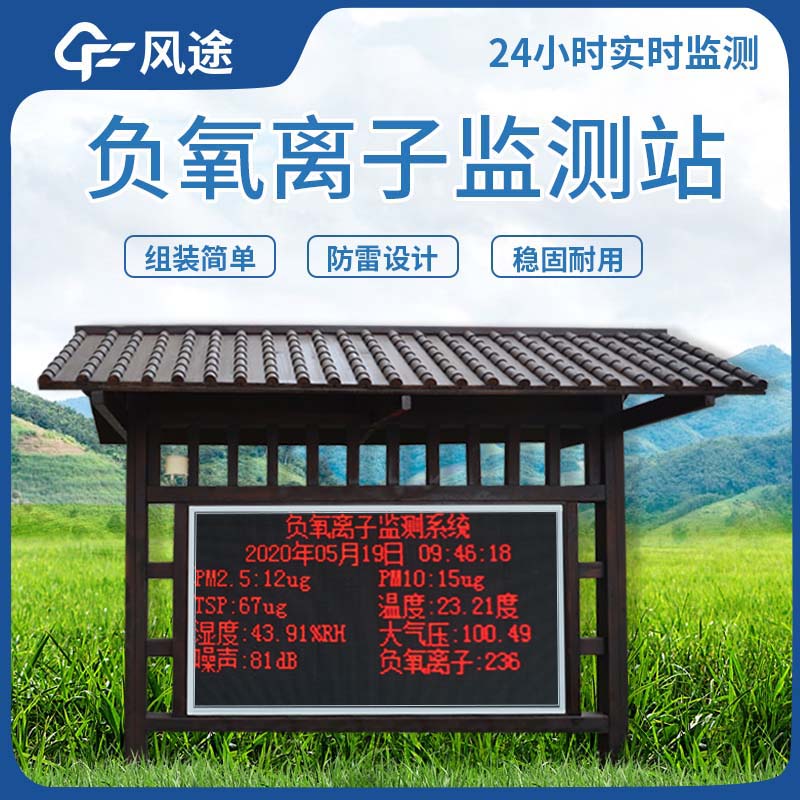Tianyi Sensor IOT Technology Co., Ltd
Sales Manager:Ms. Emily Wang
Cel,Whatsapp,Wechat:+86 15898932201
Email:info@fengtutec.com
Add:No. 155 Optoelectronic Industry Accelerator, Gaoxin District, Weifang, Shandong, China

Sales Manager:Ms. Emily Wang
Cel,Whatsapp,Wechat:+86 15898932201
Email:info@fengtutec.com
Add:No. 155 Optoelectronic Industry Accelerator, Gaoxin District, Weifang, Shandong, China
time:2025-07-31 08:51:55 source:Weather Station viewed:153 time
A Negative Oxygen Ion Monitoring Station is a professional set of equipment used to monitor the number of negative oxygen ions in the air in real-time. It records the activity status of negative oxygen ions in the air through specific sensors, then converts these statuses into readable values via a data processing module. Subsequently, the data is sent to a terminal platform through a transmission component, allowing staff or the public to check it at any time via devices such as computers and mobile phones.
An anti-corrosion wooden pavilion is a pavilion built with wood that has undergone special anti-corrosion treatment. During the treatment process, preservatives are injected into the wood under high pressure, which can effectively resist mold, insect infestation, and rain erosion, making it suitable for long-term use in outdoor scenic area environments. The appearance of an anti-corrosion wooden pavilion is usually similar to that of a traditional wooden pavilion, with structures such as columns, beams, and a roof, and its overall style is natural and simple, able to blend with the natural landscape of the scenic area.
Combining a Negative Oxygen Ion Monitoring Station with an anti-corrosion wooden pavilion is a practical scenic area monitoring solution. Staff will install the core equipment of the monitoring system, such as sensors and data collectors, inside the anti-corrosion wooden pavilion. This installation method, on the one hand, uses the anti-corrosion wooden pavilion to shield the equipment from wind, rain, and direct sunlight, reducing the loss of equipment caused by the natural environment. On the other hand, the location selection of the anti-corrosion wooden pavilion usually takes into account both the representativeness of the scenic area and the accessibility for tourists, which can more accurately reflect the concentration of negative oxygen ions in specific areas of the scenic area and also facilitate tourists to understand relevant data.
The process of online monitoring of negative ion concentration in scenic areas is a continuous working process of the equipment. The sensor records the negative oxygen ions in the surrounding air 24 hours a day without interruption. The data collector processes and stores the information obtained by the sensor, and then transmits the data to the background system at a set frequency. The background system sorts out and analyzes the data to form real-time concentration values and change trend graphs. This information will be synchronously displayed on the publicity screens in the scenic area or related APPs, realizing the instant sharing of information.
For tourists, this online monitoring method allows real-time negative oxygen ion concentration data to make them more intuitively understand the air quality of the scenic area, enhancing the sense of experience and satisfaction during the tour. For scenic area management, long-term monitoring can help grasp the variation law of negative oxygen ion concentration in the scenic area, analyze its relationship with environmental factors, and provide a scientific basis for the ecological protection, planning, construction, and management decisions of the scenic area. At the same time, open and transparent monitoring data can also enhance the credibility of the scenic area, attract more tourists to visit, and promote the sustainable development of the scenic area.

Ultrasonic resonance anemometry is a commonly used meteorological observation technology. Its principle is to utilize the propagation characteristics of ultrasonic waves in the air to measure wind speed and wind direction. When sound waves propagate in the air, their speed will be affected by the wi...
Here's a little bit of knowledge: Bridges actually freeze more easily than road surfaces.Why is that?From the perspective of heat dissipation, the temperature difference between a bridge deck and an ordinary road surface is quite understandable. The road surface is directly built on the ground,...
Although traditional mechanical wind speed and direction meters have, to some extent, met basic requirements, they have limitations in terms of accuracy, response speed, and reliability. With the advancement of technology, the 3D Ultrasonic Anemometer based on the time - difference method has been d...
Ultrasonic Smart Weather Station integrates multi-element monitoring and uses a fully digital design to achieve accurate perception and real-time transmission of environmental data...